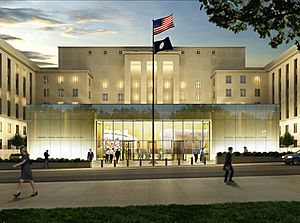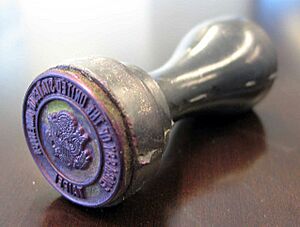National Museum of American Diplomacy facts for kids
 |
|||||
 |
|||||
| Lua error in Module:Location_map at line 420: attempt to index field 'wikibase' (a nil value). | |||||
| Established | 2000 | ||||
|---|---|---|---|---|---|
| Location | Harry S Truman Building Washington, D.C. | ||||
| Public transit access | |||||
|
|||||
The National Museum of American Diplomacy (NMAD) is a special museum in the United States. It's the first one to share the amazing stories of American diplomacy. Diplomacy is how countries talk and work together peacefully.
This museum is still being built. It gets money from a special team-up between the public and private groups. This team is called the Diplomacy Center Foundation. The NMAD is found at the 21st Street entrance of the Harry S Truman Building. This building is in Washington, D.C. and is where the U.S. Department of State has its main office. The museum is part of the Bureau of Public Affairs. Before November 2019, it was known as the United States Diplomacy Center.
Contents
How the Museum Started

In 1999, two people named Ambassador Stephen Low and Senator Charles Mathias had an idea. They started a group called the Foreign Affairs Museum Council (FAMC). This group was a non-profit, meaning it didn't aim to make money. Their goal was to help build the first museum about American diplomacy.
In 2000, Madeleine Albright, who was the U.S. Secretary of State at the time, agreed. She said the museum could be located at the Department of State building. Then, Patrick F. Kennedy, an assistant secretary, set aside a large space for the museum. In September 2013, the Foreign Affairs Museum Council changed its name. It became the Diplomacy Center Foundation. This foundation works with the U.S. Department of State. They are partners in creating and running the NMAD.
The design for the museum was approved in 2011. Building the museum officially began in late 2014. Many important people attended the special groundbreaking ceremony on September 3, 2014. These included Secretary of State John Kerry. Five former Secretaries of State were also there. They were Henry Kissinger, James Baker, Madeleine Albright, Colin Powell, and Hillary Clinton.
The Museum's Main Building
Architect Hany Hassan from Beyer Blinder Belle designed the museum's main building. This part is called the pavilion and is very large. It stretches out for visitors entering from 21st Street. The construction of this pavilion was finished in 2017. The design was made to look good with the original 1941 part of the Harry S Truman Building. This building is the main office for the U.S. Department of State.
The main entrance hall will have fun, interactive exhibits. These exhibits will help visitors learn about American diplomacy today. They will explain what U.S. diplomats do. You can find out where they work around the world. You will also learn about how the U.S. works with other countries. This includes how it affects the daily lives of regular people. In November 2019, a special preview exhibit opened. It was called Diplomacy Is Our Mission. This exhibit was created with the Smithsonian Exhibits team. It explores important ideas like safety, success, fairness, and growth. Diplomacy Is Our Mission shares old and new stories. These stories show how U.S. diplomats work with partners worldwide. Their goal is to help create a more peaceful world.
Learning at the Museum
The National Museum of American Diplomacy wants to help students and teachers learn. They do this through special education programs. A key part of their learning program is the diplomacy simulation. This is a hands-on activity where people act out a real global problem.
- How Simulations Work:
* Participants work in small groups. * They pretend to be different groups involved in a problem. For example, they might be a foreign government or the U.S. Department of State. * They have a limited time to find a solution to an international problem. * They use information given to them to form their group's ideas. * They then share, defend, and change their ideas in real time.
The museum also teaches educators how to run these simulations. They offer free materials on their website. These include a teacher's guide and videos. There are also different scenarios with background information. Short videos with experts are available too. This way, teachers can help many students learn about diplomacy. They learn about its challenges and how it works.
What You Can See
In November 2019, a preview exhibit called "Diplomacy Is Our Mission" opened. It was made with the Smithsonian Institution Exhibits (SIE). The museum will show many interesting things.
- Exhibits include:
* Madeleine Albright's special pin collection. * Stories about how Shirley Temple Black became an ambassador. She served in Ghana and then Czechoslovakia. She was also the first woman to be the U.S. chief of protocol. * Items from the TV show Madam Secretary.
Working with Others
The National Museum of American Diplomacy celebrates important moments in American diplomacy. They do this with talks, movie showings, and ceremonies. These events feature people who work in foreign service. They also include experts on foreign policy, historians, and regular citizens who help with diplomacy. These programs happen in the museum's main hall.
NMAD hosts discussions about diplomacy for everyone. They also hold events with other parts of the State Department. They work with other U.S. government groups, organizations, and embassies. NMAD also hosts outside events. These include testing new exhibits and a special event called a diplomacy-focused hackathon.


